In this issue Anna Loseva, Kevin Stein and Tülay Önder discuss collaboration – what is has meant to them as teachers, and what impact is has had on their learners.
|
|
|
|
In this issue Anna Loseva, Kevin Stein and Tülay Önder discuss collaboration – what is has meant to them as teachers, and what impact is has had on their learners.
|
|
|
|
 by Anna Loseva
by Anna Loseva
I remember in the methodology course at the university part of the material we were covering was the theory of how one (i.e. a teacher) can set up collaboration projects with learners from other countries, a pen pal kind of story. During seminars we would take notes on how students could write letters to one another and exchange postcards, asking and answering questions about holidays, food, famous sights, and other coursebook covered areas of “interest”. I was excited at the sound of it – what a thrilling experience for students it must be to actually use the language to communicate with others in English! I almost envied the learners of those days for having an opportunity to enjoy classes that I had never had myself. And then, remembering that I was supposed to be the teacher offering that opportunity… I could not fathom how exactly and where I would find those exchange partners.
That was year 2006. Five years later, through Twitter and Facebook, I found myself in a community of English language teachers worldwide, and now, in 2016, a project connecting classrooms from different parts of the globe sounds like a relatively simple thing to set up on my own…. Or does it?
I will never forget the first ever online exchange that I took part in. A teacher from France and I decided to connect our students, university science majors from France and Russia, by way of a wiki. To cut this not-so-long story short, the interaction never went further than mutual introductions. For my part, there was no way time-wise to do it in class, neither did we have an access to computers, so I could not follow through with even the first basic task. The initial enthusiasm subsided pretty quickly, possibly aided by the fact that the wiki activity was not obligatory for getting a grade for the course, for my students at least. There was no task following the introductions, then the course was soon over for me and my students, and thus the collaboration naturally faded.
What I could learn from that experience was that it should be clear for the teachers what the purpose of collaboration is, what the tasks are, the structure, and possibly even deadlines. Enthusiasm and energy of two teachers were obviously nowhere near enough to sustain a project involving twenty busy university students. In the years following that first lumpy pancake of an experience, I still wanted to open my classrooms to the online world of real communication in English, but I was cautious about starting a whole big project as I didn’t have confidence in myself. Instead, with various groups of students at various times, we created blogs and opened up their entries to the public for comments, we asked questions to Americans and to the British on the Lino boards and then devoured the many answers we got from teachers all over the world. Those activities spiced up the routine and opened space for interesting conversations in class.
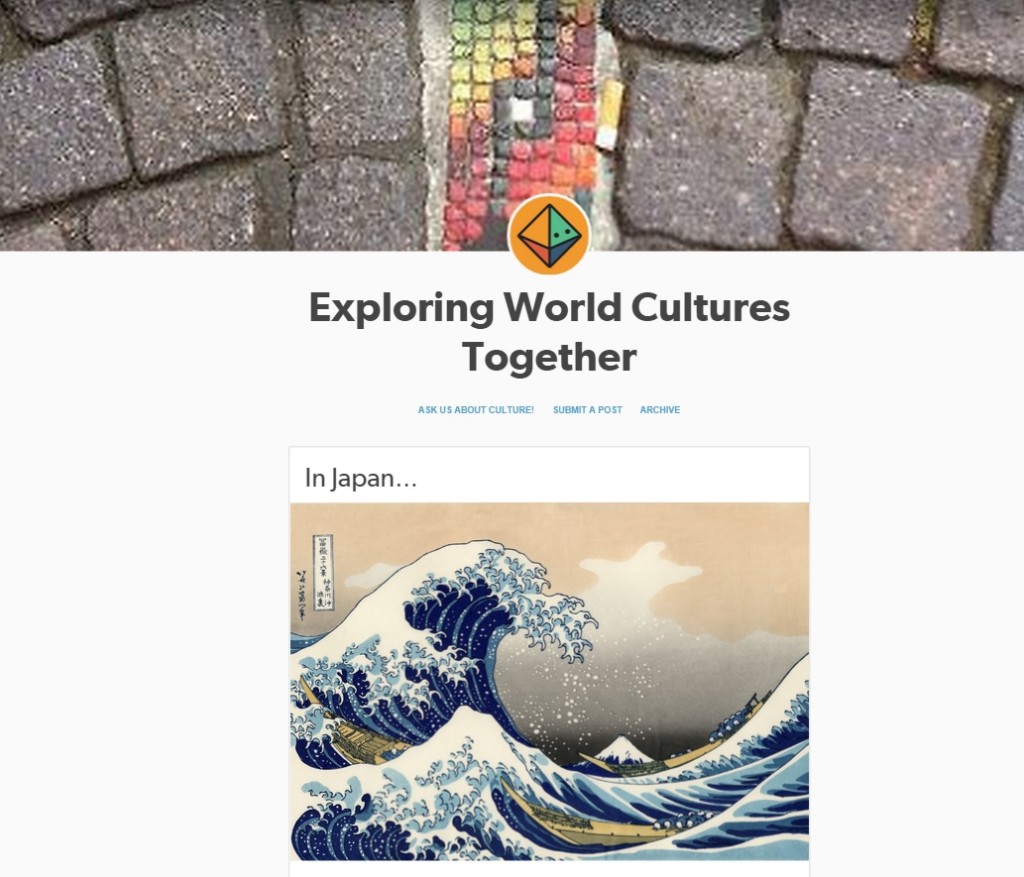
One of the courses I have been teaching in my new job in a high school in Japan is a culture course, part of which for the past four months has been a culture exchange project. I believe it was much better thought through than my first experience. The culture exchange is run through a Tumblr blog used to showcase students’ work, a Google Doc for the original discussion of the project idea by the teachers, and Facebook messages back and forth to keep each other up-to-date. Out of ten teachers who originally showed interest, five have committed and contributed with their students from South Korea, Russia, and Canada. We have done what now seems to be many things: students co-wrote blog entries about various facts from their cultures, their peers wrote questions based on these texts on Lino boards (you can see examples here and here). That was the only explicit way for students to engage in a conversation, as comments on the blog are disabled. My students also made presentations of unique Japanese activities and phenomena and some of them agreed to share their work on the blog for others to see.
With the school year almost over here in Japan, we are also nearing the end of this culture exchange, and so I follow my tradition of analyzing the work done. Reflecting on these few months, I came up with a list of questions teachers should probably ask themselves and have clear answers to before setting out on a big collaboration journey:
It is certainly clear by now that when it comes to connecting classrooms around the world, I am an enthusiastic newbie, with a limited experience behind my back but an earnest desire to give it a chance with my students. I feel driven by my initiative in the beginning stages of a project and then gradually I lose grip of it. Realizing that the questions posed above are insufficient, I consider this post a shout-out to those teachers who are more competent in the area of organizing international collaboration projects, to teachers who have gone through the first try-outs and can now share their stories of success (or failure?), offer their tips and guidelines. All these could serve a big helping hand for teachers like me, who need to steer the energy into the right direction with the specifics of preparation stages, further steps to take, and objective criteria of a project success, in addition to a student’s “I like it!” on a feedback form.
 by Kevin Stein
by Kevin Stein
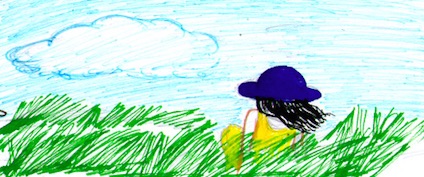
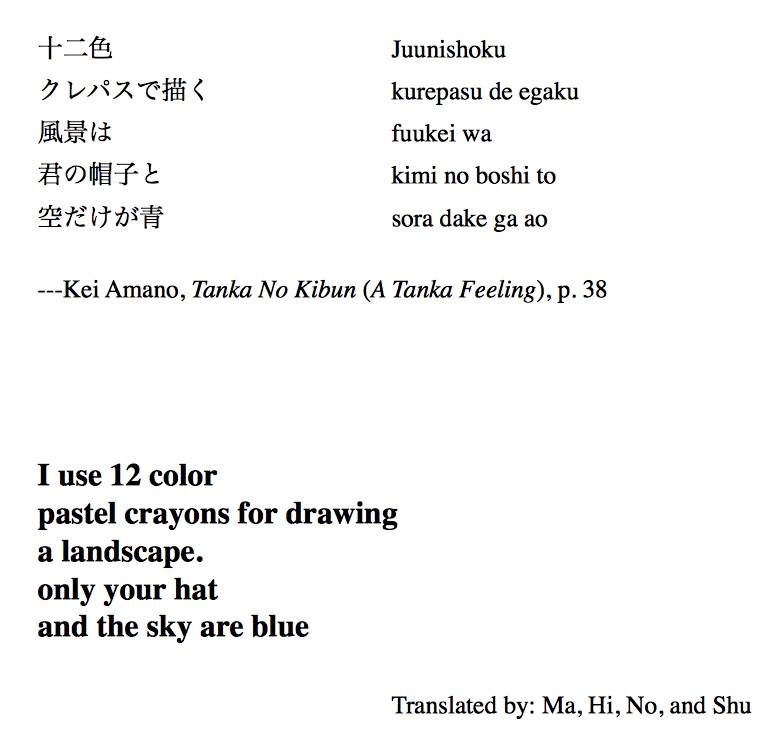
For me, I’ve found my release in poetry. On the crowded train ride home, I will often open a book of Tanka, traditional Japanese short poetry, and so lose myself in the small gem of a moment captured in five lines. I will worry over these poems the same way a small child might rub a shiny, smooth stone. And every once in a while I will try to write poetry as well.
Poetry, it’s how I ended up in an unexpected conversation (as online conversations so often are) with a poet and English teacher in India, Tesal K. Sangma. At first we did not talk about teaching, but about our love for traditional poetry forms. Tesal sent me a poem, Soul Bird by Temsula Ao. It was the kind of poem that left me feeling I had traveled for hundreds of miles over the course of less than a page. Slowly our conversation moved from poetry to our classroom experiences. Tesal was required to teach poetry in his classes, but he was having difficulty finding poetry that his students could understand and identify with. At the same time, I was doing a tanka translation project with my students, but they had no audience with whom to share their poems.
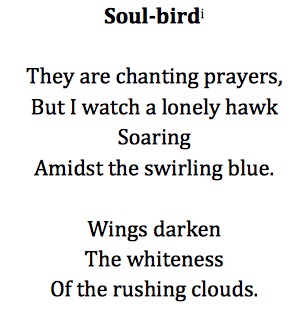
This is all we had to start with, just the idea of one group of students translating traditional poetry from their first language into English to be used by another group of students studying literature. As I explained the idea to my students, one boy, P-Kun, looked at the poem about pastel crayons he and his group had been struggling over, and added the following line at the bottom of the page, “From children to adults, many people use pastel crayons to draw pictures in Japan.” He explained that he was worried that the students in India would read the word crayon and imagine that the narrator was a child. Soon after, all of the other groups had added culture footnotes to their poems. We sent the poems and cultural footnotes off to Tesal to share with his students. And Tesal took pictures of his students, huddled over their desks, pencils in hands, reading over the poems that my students had translated. When I shared these pictures with my students, there was a moment of silence, a kind of muffled cloud of disbelief. When one of my students, H-Chan, asked the question that anyone would ask in such a situation, “What did they think about the poems?” It was in this moment of true curiosity of how my students’ language had affected someone 5000 kilometres away, that the poetry they were writing became part of a larger conversation firmly embedded in their own lives.

My students spent a solid hour writing out questions for the students in India.
These were questions that showed flashes of critical insight into the structure and nature of poetry. Did the students in India think that the narrator of a certain poem was a boy or a girl? Was the poem’s tone hopeful or sad? Their questions also moved beyond the small frame of the poem itself. My students used the poems to ask questions about the lives of the students in India. Questions like, “What is the most beautiful scenery you’ve ever seen from a bicycle?” and “Do high school students in India have boyfriends and girlfriends?” I worked with my students to build a Lino Board and it was through this interactive medium that the students in India and Japan continued their conversation. In the end, my students decided to collect all the stages of this project into a book, Exchange Through Tanka Project.

“Find something you are passionate about outside of teaching.” It’s some great advice. I would add a caveat to it. “Find something you are passionate about outside of teaching, but don’t be afraid to bring that passion into your classroom.” Don’t be afraid to let your passion connect you to other teachers and to your students. Because it is within the soil of that shared passion that collaboration begins. Successful collaboration is not simply about engaging with others. In the end, collaboration is about creating the very ground beneath our feet as we walk together on a completely new path.
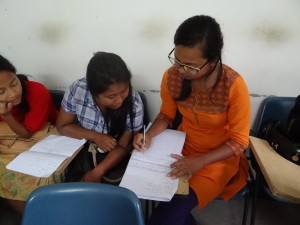 [This post is dedicated to the students in the Bachelor of Social Work programme at Martin Luther Christian University in Meghalaya, India who inspired my students to think deeper, ask questions, and search for the personal meaning in the poetry around them.]
[This post is dedicated to the students in the Bachelor of Social Work programme at Martin Luther Christian University in Meghalaya, India who inspired my students to think deeper, ask questions, and search for the personal meaning in the poetry around them.]
 by TÜLAY ÖNDER
by TÜLAY ÖNDER
I have been working in Mehmet Özcan Torunoğlu secondary school since 2008 with teenagers aged 11-14 years old. The journey that I will tell you about started for me and my students in 2009, changing our lives a lot. During these seven years, l took 70 students and 40 teachers to different European countries for international project activities without any cost. These projects were provided by the Comenius programme in 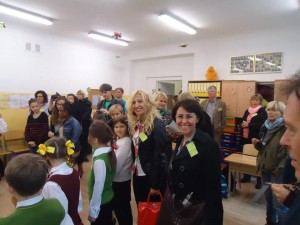 the past but for the recent two years they are known as Erasmus+. Every year several countries come together on an online platform, such as eTwinning, create a project incorporating many subjects, and apply for a grant. If the application is approved, each country gets a fund and starts working on the project. In the process, any project involves two kinds of meetings for participants: the Transnational meetings, organized solely for the teachers to plan the activities together, and the Short-term Teaching Learning meetings, in which both teachers and students work out the activities according to the plan.
the past but for the recent two years they are known as Erasmus+. Every year several countries come together on an online platform, such as eTwinning, create a project incorporating many subjects, and apply for a grant. If the application is approved, each country gets a fund and starts working on the project. In the process, any project involves two kinds of meetings for participants: the Transnational meetings, organized solely for the teachers to plan the activities together, and the Short-term Teaching Learning meetings, in which both teachers and students work out the activities according to the plan.
Experience
Our first international project within the Comenius programme was called ‘’Local and national symbols’’. For two years eight participating countries presented their own symbols, traditions, and elements of culture to one another. The budget that we recieved to cover travel expenses and activites we carried out  in the course of collaboration allowed 20 teachers and 20 studenst to travel around Europe and share their presentations about the Turkish culture. Most of the students had a chance to travel abroad by plane for the first time in their life, and most of my collegues had a chance to visit another country. Later on we successfully applied for another project called ‘’European gardens’’. Students in our school learnt a lot about gardening, enviroment, and the process of growing plants, and 16 students and 22 teachers travelled to many countries in Europe again.
in the course of collaboration allowed 20 teachers and 20 studenst to travel around Europe and share their presentations about the Turkish culture. Most of the students had a chance to travel abroad by plane for the first time in their life, and most of my collegues had a chance to visit another country. Later on we successfully applied for another project called ‘’European gardens’’. Students in our school learnt a lot about gardening, enviroment, and the process of growing plants, and 16 students and 22 teachers travelled to many countries in Europe again.
Last year our school applied for two projects offered by the Erasmus+ programme, “Water” and ’’Healthy lifestyles”. To our joy, both were approved yet again! My collegues and all the students have been working hard on these two projects lately. As a result, we have one activity for each day at school and this made my whole school more international, too. For instance, for the Water project students prepared water boxes to put out on the territory surrounding our school for the street animals. Students wanted stray cats and dogs to drink clean water. Some students are responsible for refilling the cups every day. In relation to this project, science teacher gave seminars about the importance of water in our lives, while other teachers carried out various experiments and conducted classroom activities to support the topic across curriculum.
Impact – for teachers, students, parents
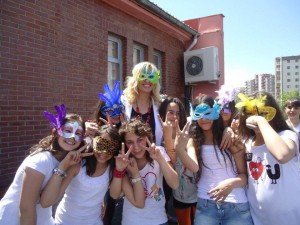 Working on these projects, my students have greatly improved their language and ICT skills as they started to use technology often and in a good way. Their art skills also have got a boost because they have prepared many postcards for their friends in different countries. Now, on special days such as Christmas and New Year, they make posctards on their own, without even asking me, because they know that there are always teachers and students who are waiting for them.
Working on these projects, my students have greatly improved their language and ICT skills as they started to use technology often and in a good way. Their art skills also have got a boost because they have prepared many postcards for their friends in different countries. Now, on special days such as Christmas and New Year, they make posctards on their own, without even asking me, because they know that there are always teachers and students who are waiting for them.
As a result of our international experiences, both school staff and pupils in our school have noticed how important English is, how a foreign language in real life connects people from all over the world. During the visits all students are hosted by local host families, which makes students learn more about the local cultures. Besides, this collaboration is not just a chance to travel to Europe, but also an opportunity to host teachers and students, too. When families of our learners agree to host their peers from other countries, they all try to share Turkish culture in a natural, casual way.
It is interesting to see the impact our exchanges had for the parents. When we first started to take part in project visits abroad, parents were anxious about sending their kids to Europe. Now many of them are waiting for their turn! Moreover, these projects made parents of our students more internatonal, too. Some of the kids connected their parents from different countries, who then started to send e-mails to each others and even making future plans for independent visits.
The experience organizing projects has changed my life, too. My life is richer now as l have many friends and collegues from all over the world. Through connections I’ve established on social media, it became possible for our school to get an invitation from an American high school to come for a visit and make a presentation about our country, tell about our learning adventures. With the help of these projects, we stepped into another world, made friends with students and teachers from all over Europe, created links between schools, pupils, and teachers.